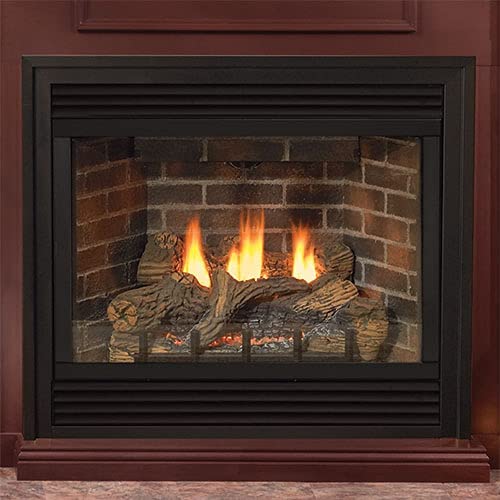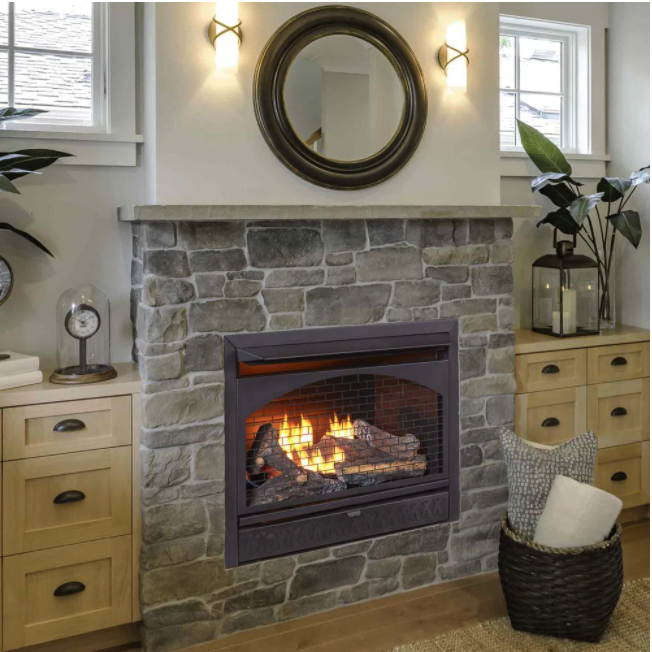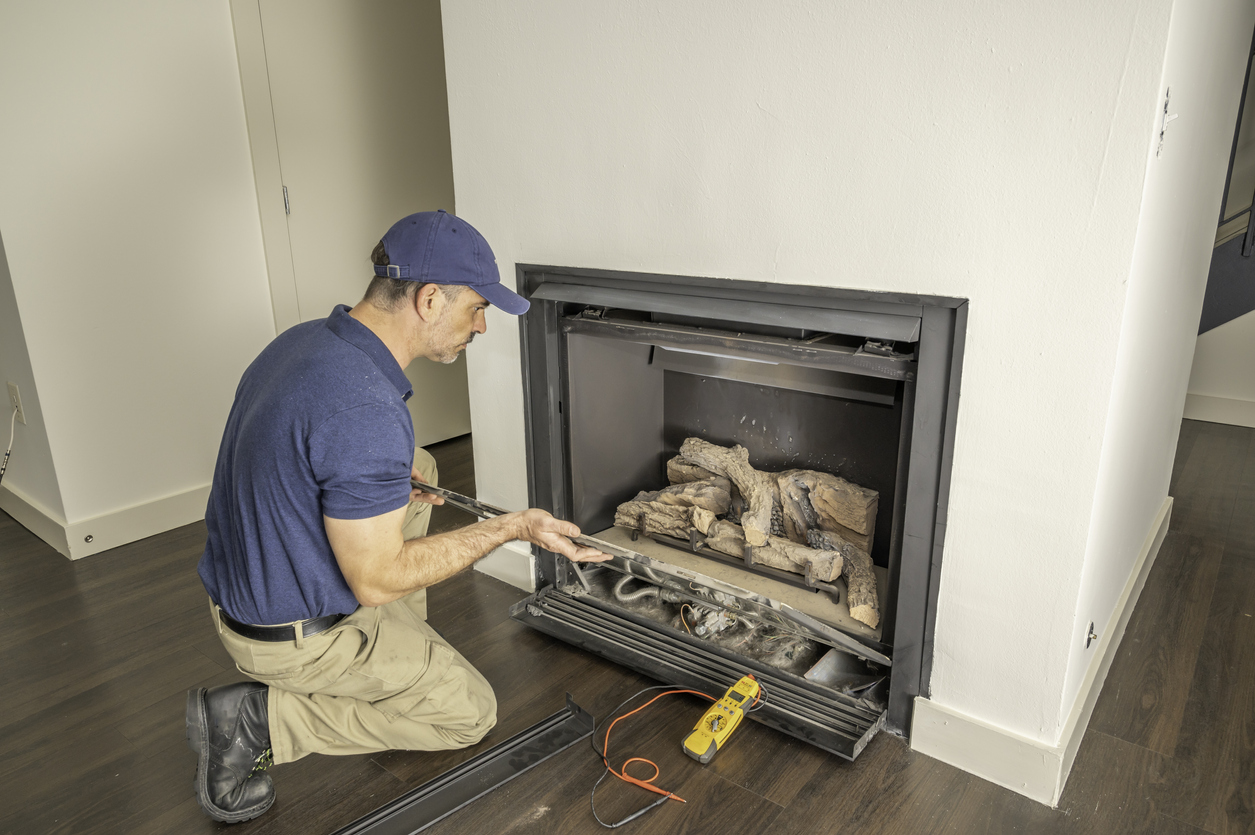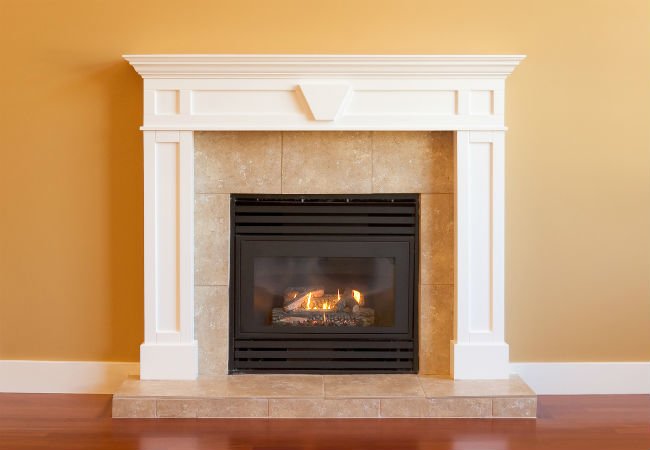We may earn revenue from the products available on this page and participate in affiliate programs. Learn More ›
Nothing feels quite as nice as the cozy glow of a warm fire on a blustery winter’s day. While wood-burning models are the age-old standard, most of today’s new fireplaces are fueled by gas, which eliminates the messy ashes and soot leftover from wood fires. Traditional gas fireplaces, like their wood-burning cousins, require an exhaust flue (vent) to remove harmful fumes from the home. When possible, an existing chimney is used to run a new flue, but in a home without a chimney, the high cost to install venting can sideline the project permanently.
There is, however, an alternative: the ventless fireplace.
Ventless fireplaces are designed to burn gas more efficiently than vented versions, resulting in far fewer fumes and no need to install a flue. Yet not everyone is a fan of these newfangled fireplaces—in fact, they are banned in some states. Keep reading to learn important details that will help you decide if a ventless fireplace is right for your home.
The Differences Between Vented and Ventless Fireplaces
The two types of gas fireplaces function differently, with vented fireplaces using ductwork to enable potentially dangerous fumes to be expelled outside. Ventless fireplaces, on the other hand, burn gas in a different way, one that doesn’t create as many fumes, and therefore don’t require venting. In addition to the option to create or convert a built-in ventless fireplace, freestanding ventless propane fireplaces are also an option.
Vented Fireplaces

A traditional vented gas fireplace, such as the Empire Tahoe Deluxe Direct-Vent Fireplace, can be fueled by either natural gas or propane and has two vents that run to the exterior of the house. The intake vent draws fresh air into the fireplace while the exhaust vent safely removes fumes of the combustion (burning) process. You’ll pay $3,500 to $8,000 or more for a direct vent gas fireplace, depending on fireplace quality and the amount of remodeling to be done, to purchase a vented gas fireplace and have it professionally installed. Keep in mind that most communities require a certified gas contractor or a licensed plumber to install and hook up gas lines, so this is by no means a DIY project.
Ventless Fireplaces
A ventless fireplace, such as ProCom’s Dual Fuel Propane and Natural Gas Fireplace Insert, contains a regulator that produces a fine mixture of gas and air in a way that allows the gas to burn cleanly. This greatly reduces the fumes associated with the traditional natural gas fireplace. Federal regulations require testing of ventless fireplaces and ventless fireplace inserts to ensure that they function as intended. Ventless fireplace burners are tested in national laboratories and must meet federal safety and health standards before they can be sold to the public. Expect to pay $1,000 to $5,000 to purchase a ventless fireplace and have it professionally installed.
Many of today’s models include built-in carbon monoxide detectors and oxygen detection sensors, which are designed to monitor air quality in the room. Because a ventless fireplace does not have a fresh-air intake vent, the fire burns the oxygen in the room. If the oxygen drops to an unhealthy low, the oxygen detector will shut off the fireplace automatically. Likewise, should the carbon monoxide detector sense the gas, it will also shut off the fireplace automatically. Manufacturers often recommend homeowners leave a window open while operating the fireplace, but, in cold weather, that’s not always feasible.
A note about fuel: Ventless fireplaces are powered by either natural gas (NG) or propane (LG), and while you can shop for models that display either the NG or LG designation, virtually any gas fireplace can be converted from one type of fuel to the other through the installation of a converter. Your plumber can convert any fireplace you choose to the type of gas you use in your home, whether you want a ventless propane fireplace or a ventless natural gas fireplace.
RELATED: 2025’s Best Carbon Monoxide Detectors for Home Safety, Tested
A Heated Controversy

Despite the testing and safety precautions, ventless fireplaces have a long list of detractors. States including California and Massachusetts have banned the installation of ventless fireplaces, and the devices are not permitted in HUD housing. Individual municipalities may also ban them, so check with your local building authority before you purchase a ventless fireplace.
While the Centers for Disease Control and Prevention (CDC) does not specifically track deaths or injuries from exposure to the carbon monoxide gas produced by ventless fireplaces, about 50,000 Americans visit an emergency room annually due to carbon monoxide poisoning, and nearly 450 die.
According to the International Association of Certified Home Inspectors (InterNACHI), even though ventless fireplaces greatly reduce toxic fumes, they will still release some small amount into the home, which increases the risk of exposure to carbon monoxide. Additionally, ventless fireplaces produce water vapor as a byproduct of the combustion process, which can lead to high levels of humidity in the home and an increased risk of mold growth.
The Pros and Cons of Ventless Gas Fireplaces

Pros
- Installing ventless fireplaces is more affordable than installing vented fireplaces because there is no need to remodel in order to run a flue.
- Ventless fireplaces do not produce soot and ash as wood-burning fireplaces do.
- Ventless fireplaces can be located in any room of the house, making it possible to add supplementary heat right where you want it.
- The flames produced by ventless fireplaces create every bit as much ambience as those produced by vented fireplaces.
- Ventless fireplaces are more energy efficient than vented fireplaces because no heat escapes up the flue, so you’ll save money on gas utility bills. A vented gas fireplace uses more gas to create the same level of warmth because some of its heat escapes through the flue.
Cons
- Despite producing far fewer fumes than vented gas fireplaces, a small amount of fumes will still be emitted into your house.
- Ventless fireplaces are not permitted in some areas. If you install one where it’s against local codes, you may be asked to remove it and you may be fined for noncompliance with local building codes.
- Gas combustion creates a small amount of water vapor, which can make your home feel humid or muggy.
RELATED: Gas Fireplace Insert Cost: Here’s What to Expect You’ll Pay
Alternatives to Ventless Gas Fireplaces
While a vented gas fireplace is the most obvious alternative to a ventless gas fireplace, the hassle and expense of a vented fireplace may be something you’d like to avoid.
In that case, you might want to look into an electric fireplace. You’ll find dozens of options on the market, many of which offer the ambience and warmth of a gas fireplace. Electric fireplaces do not produce potentially harmful fumes that need to be vented, and you’ll find options in a variety of sizes and styles.
Another option is an ethanol fireplace, also known as a bio or or bio-ethanol fireplace, which is ventless and runs on ethanol fuel. It produces real flames and generates no odors or fumes.
Finally, of course, there’s the classic wood-burning fireplace.
Safe Operating Guidelines for Ventless Gas Fireplaces
If ventless gas fireplaces are legal where you live and you choose to install one, reduce potential dangers by carefully following the manufacturer’s directions. The following tips will also help ensure your safety.
- Arrange the ventless gas logs only as recommended by the manufacturer. Your owner’s manual will specify the correct configuration.
- Once a year, inspect the condition of the ventless gas logs and replace any that are cracked, and clean them as recommended in your manual.
- Following the manufacturer’s instructions, test both the carbon monoxide and the oxygen detection sensors detectors (if present) at least once a year to make sure they’re working.
- Install additional carbon monoxide detectors throughout your house. Carbon monoxide is odorless and tasteless, and if the detector on your fireplace malfunctions, the other detectors will let you know if carbon monoxide is present in your home.
- Have a fireplace professional service your ventless unit annually in fall to ensure that your fireplace is in good working order before winter weather arrives.
- Keep flammables, such as curtains, upholstered furniture, blankets, and papers a minimum of 3 feet away from the fireplace. Be sure to warn young children not to touch its surface, which can become very hot.
Final Thoughts

While some homeowners may have concerns about whether a ventless gas fireplace is right for their home, improved technologies have made this type of fireplace safer than ever.
Modern regulators enable the gas to burn cleanly, with minimal production of harmful fumes. And with built-in carbon monoxide and oxygen detectors, modern ventless gas fireplaces ensure that the minimal toxic fumes that are released are not at dangerous levels.
These safety measures, combined with the relative simplicity of installation, make ventless gas fireplaces an attractive option for many consumers.
FAQs About Ventless Gas Fireplaces
Still considering a ventless gas fireplace, but have just a few more questions? Fortunately, we have a few more answers. Read on to gather a few more tidbits of info.
Q. Are ventless gas fireplaces safe?
Ventless fireplaces undergo rigorous testing to ensure they meet federal safety and health standards. They do, however, release tiny amounts of carbon monoxide, which is concerning to some consumers. Many models have carbon monoxide and oxygen sensors to further ensure safety. Despite these precautions, some states and municipalities have an outright ban on ventless fireplaces because of safety concerns.
Q. How long can you run a ventless fireplace?
Most experts recommend that you run a ventless fireplace for no longer than 3 hours at a time, and some suggest running it for only up to 2 hours. Check with the manufacturer of your particular model for more specific recommendations.
Q. How do you vent a ventless fireplace?
You don’t vent a ventless fireplace. The fireplace is constructed in such a way that it does not require venting.
Q. What maintenance is required for a gas fireplace?
First and foremost, a gas fireplace should be thoroughly cleaned once or twice a year, depending on how often you use it. It’s also very important to have your gas fireplace professionally inspected every year.
Q. What does it cost to convert a wood-burning fireplace to gas?
The cost to convert a wood-burning fireplace to a gas fireplace can vary greatly, depending on a number of factors, including whether you are using an insert or not. Expect to pay anywhere from $500 to $8,000, with an average cost of about $4,000.


